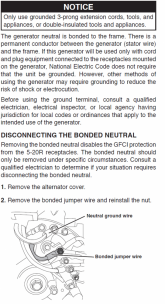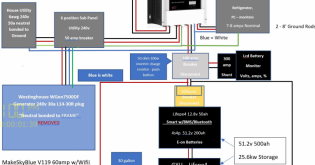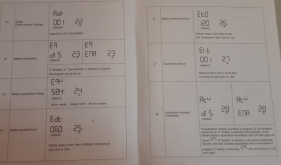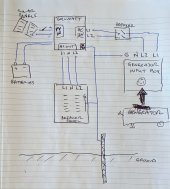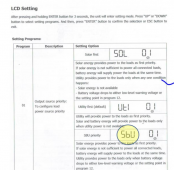Joe BoyKey
Watts, Watts, more Watts
Ok, searched and read 10+ post here and numerous post elsewhere, got a solid answer from BB @ Northern Arizona Wind & Sun Solar Forum - THANKS
Just need peace of mind, not get electrocuted and mostly not FRY my inverter, thanks in advance, Joe.
Items involved:
1. Growatt SPF-6000T-DVM - Low frequency split phase 6kw 240v Inverter charge controller - feeding Garage
2. Westinghouse WGen7500DF Generator - 240v 30a L14-30r plug, won't be using 120v ground fault outlets ever!
See pic, Generator ships with "neutral bonded to FRAME", Growatt only requires L1 L2 and Ground, no neutral,
Growatt takes L1 L2 and ground and makes its own neutral (70lbs transformer), neutral is bonded to ground in the House breaker box. (all as is now)
Want to add a breaker to 6 position breaker panel in pic with lockout for Utility or Generator manual transfer - Generator outside -
jumper cable from L14-30r to wall mounted Receptacle hard wired to Growatt sub-panel.
Questions:
1. L1 L2 to Breaker, ground to ground, no neutral - is this correct?
2. was told to leave neutral bonded to FRAME on generator - is this correct?
3. do i ground the generator frame to ANYTHING? - only ground other than House grond at house panel is Solar panels???
Sorry for the same question over again, just not a trailer or boat and no transfer switch - just having trouble with "1 single Neutral to Ground period"
If breaker to Growatt is off, grounds still bonded, and the breaker from Generator is on - where is the potential to flip breaker in case of short/overload?
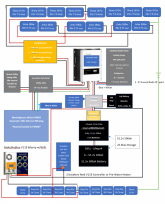
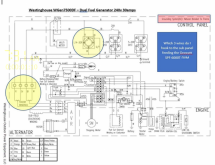
Just need peace of mind, not get electrocuted and mostly not FRY my inverter, thanks in advance, Joe.
Items involved:
1. Growatt SPF-6000T-DVM - Low frequency split phase 6kw 240v Inverter charge controller - feeding Garage
2. Westinghouse WGen7500DF Generator - 240v 30a L14-30r plug, won't be using 120v ground fault outlets ever!
See pic, Generator ships with "neutral bonded to FRAME", Growatt only requires L1 L2 and Ground, no neutral,
Growatt takes L1 L2 and ground and makes its own neutral (70lbs transformer), neutral is bonded to ground in the House breaker box. (all as is now)
Want to add a breaker to 6 position breaker panel in pic with lockout for Utility or Generator manual transfer - Generator outside -
jumper cable from L14-30r to wall mounted Receptacle hard wired to Growatt sub-panel.
Questions:
1. L1 L2 to Breaker, ground to ground, no neutral - is this correct?
2. was told to leave neutral bonded to FRAME on generator - is this correct?
3. do i ground the generator frame to ANYTHING? - only ground other than House grond at house panel is Solar panels???
Sorry for the same question over again, just not a trailer or boat and no transfer switch - just having trouble with "1 single Neutral to Ground period"
If breaker to Growatt is off, grounds still bonded, and the breaker from Generator is on - where is the potential to flip breaker in case of short/overload?







